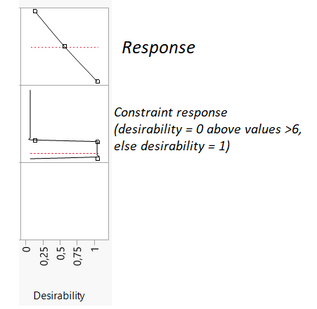- JMP will suspend normal business operations for our Winter Holiday beginning on Wednesday, Dec. 24, 2025, at 5:00 p.m. ET (2:00 p.m. ET for JMP Accounts Receivable).
Regular business hours will resume at 9:00 a.m. EST on Friday, Jan. 2, 2026. - We’re retiring the File Exchange at the end of this year. The JMP Marketplace is now your destination for add-ins and extensions.
- Subscribe to RSS Feed
- Mark Topic as New
- Mark Topic as Read
- Float this Topic for Current User
- Bookmark
- Subscribe
- Mute
- Printer Friendly Page
Discussions
Solve problems, and share tips and tricks with other JMP users.- JMP User Community
- :
- Discussions
- :
- Re: Constrain Response
- Mark as New
- Bookmark
- Subscribe
- Mute
- Subscribe to RSS Feed
- Get Direct Link
- Report Inappropriate Content
Constrain Response
Hello everyone,
I'm stuck on a model what I first thought to be an easy one.. So I did a screen with 5 continuous factors and initially one response that I want to minimize. Later I needed to add a second response since I'm limited by inherent properties of the runs. The second response should not go over 6 while the first response should be minimal. However, I don't want to include my second response in the model creation but rather constrain the first response to yield a minimum in the desired range (second response <6). About half of my data is above the threshold of response 2 thus I don't want to exclude them.
Is there a way to do this in JMP?
Thanks and all the best,
FactorAlligator
Accepted Solutions
- Mark as New
- Bookmark
- Subscribe
- Mute
- Subscribe to RSS Feed
- Get Direct Link
- Report Inappropriate Content
Re: Constrain Response
Hi @FactorAlligator,
You're right not to exclude data from the modeling step even if it doesn't match your final requirements. I don't know if the option I will share will exactly suit your needs, but here is a possibility :
You can create a model based on these 2 responses (make sure to check the option "Fit Separately" in the Fit Model platform) with the terms you specify.
In the red triangle of the Fit Group, click on Profiler (Profilers in Fit Group Reports (jmp.com)). From here, you will be able to specify for each response the target, limits and importance (in your example, you'll have to adjust the relative weight of your constraint response to be sure the optimum found by JMP will respect your constraint).
There is a lot of flexibility on how to set up your desirability function (Desirability Profiling and Optimization (jmp.com)), so we can imagine that you may set up the desirability profile of your response and "constraint response" like this :
This way, even if you're not interested in the exact values from response 2 (constraint), creating a desirability function for this response will enable to be sure that this constraint is taken into consideration in the Profiler optimum.
I hope this answer will help you,
"It is not unusual for a well-designed experiment to analyze itself" (Box, Hunter and Hunter)
- Mark as New
- Bookmark
- Subscribe
- Mute
- Subscribe to RSS Feed
- Get Direct Link
- Report Inappropriate Content
Re: Constrain Response
Hi @FactorAlligator,
You're right not to exclude data from the modeling step even if it doesn't match your final requirements. I don't know if the option I will share will exactly suit your needs, but here is a possibility :
You can create a model based on these 2 responses (make sure to check the option "Fit Separately" in the Fit Model platform) with the terms you specify.
In the red triangle of the Fit Group, click on Profiler (Profilers in Fit Group Reports (jmp.com)). From here, you will be able to specify for each response the target, limits and importance (in your example, you'll have to adjust the relative weight of your constraint response to be sure the optimum found by JMP will respect your constraint).
There is a lot of flexibility on how to set up your desirability function (Desirability Profiling and Optimization (jmp.com)), so we can imagine that you may set up the desirability profile of your response and "constraint response" like this :
This way, even if you're not interested in the exact values from response 2 (constraint), creating a desirability function for this response will enable to be sure that this constraint is taken into consideration in the Profiler optimum.
I hope this answer will help you,
"It is not unusual for a well-designed experiment to analyze itself" (Box, Hunter and Hunter)
- Mark as New
- Bookmark
- Subscribe
- Mute
- Subscribe to RSS Feed
- Get Direct Link
- Report Inappropriate Content
Re: Constrain Response
Hi @Victor_G,
thank you so much! This group profiler was the missing link and the solution you provided was exactly what I was looking for!
Best,
FactorAlligator
- Mark as New
- Bookmark
- Subscribe
- Mute
- Subscribe to RSS Feed
- Get Direct Link
- Report Inappropriate Content
Re: Constrain Response
Perfect, glad that it helped you !
There might be other solutions as well, but this option is quite straightforward, provided the second response is influenced by the same factors (so you are able to have a "good enough" model of the second response to be used in the Profiler).
All the best,
"It is not unusual for a well-designed experiment to analyze itself" (Box, Hunter and Hunter)
- Mark as New
- Bookmark
- Subscribe
- Mute
- Subscribe to RSS Feed
- Get Direct Link
- Report Inappropriate Content
Re: Constrain Response
This was my today's challenge. Thanks to your input, Victor, I solved it! :) Merci!
Recommended Articles
- © 2025 JMP Statistical Discovery LLC. All Rights Reserved.
- Terms of Use
- Privacy Statement
- Contact Us


